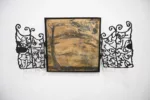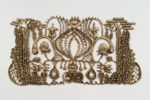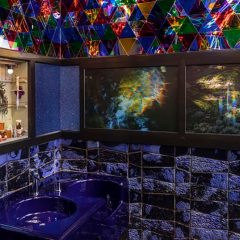—>Sam visits Fleisher-Ollman’s new gallery and encounters some heady art, both abstract and narrative.—-the Artblog editors———————–>
One of the first things you’ll notice in Fleisher-Ollman’s new Arch Street location is the high ceilings. Compared to the former location in the historic 1616 Walnut Street office building, where a 1930s-style doorman greeted guests and the low-ceilinged gallery felt like a hidden vault, it seems like Fleisher-Ollman has moved forward in time, not just a few blocks diagonally across City Hall. An Edgar Tolson statue of a dog greets visitors from outside the elevator doors. Down the hallway, you will find the entryway to the 5,000-square-foot gallery space with hardwood floors and 16-foot-high ceilings. Though the new space is a single large room, it has a few nooks and corners that allow some works to be seen in separate, private spaces that give gallery visitors a sense of unexpected exploration. Fleisher-Ollman opened in the new space at 1216 Arch Street on April 1, in what has been dubbed NoChina– the strip of galleries to the north (and arguably the west) of Chinatown, which includes the Fabric Workshop and Museum, AiA and, just two blocks over, Space 1026.
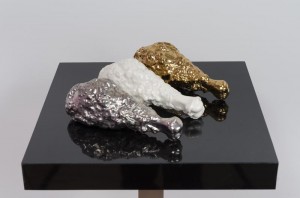
The eleven gallery artists in the current show, New Wine, New Bottle, seem primarily concerned with creating work according to their internal, personal relationships with spaces and objects. While in many cases the subject matter can be interpreted as primarily topical, the unifying thread is personal narrative. The second exhibition at Fleisher-Ollman’s new space consists largely of two-dimensional works. The theme could be described as showing off the vivacity and willingness to experiment represented by this talented group. Their playfully-complex works are the “new wine” and the gallery space is the “new bottle.”
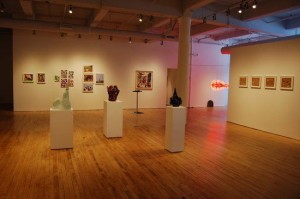
A view of the installation of New Wine, New Bottle at Fleisher-Ollman gallery. Seen in the foreground are the sculptures of Paul Swenbeck.
The space and the spacey – Isaac Lin, Kate Abercrombie, Mark Mahosky
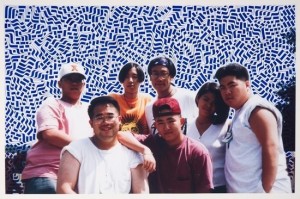
Isaac Tin Wei Lin’s small works on paper – photographs with ink or collage patterns applied directly to them – address both the memorializing and internalization of experience. The original photographs capture a variety of scenes, most of which seem to be taken from a vacation of some kind, but the scene is surrounded by the ink embellishment, which turns the whole into a testament to obsessive geometric mark-making. This added texture is a frame, encasing the subject of the photograph in a dizzying geometric web that recalls both absent-minded doodling and playful Matisse-inspired shapes. (Lin’s vocabulary of shapes appear in various collections on their own panels as well.)
The figures themselves, while encircled, exist as players in the world of the past, memorialized by the photo and by Lin’s psychedelic additions. In these works, the separation of dream from reality is akin to the separation of public and private.
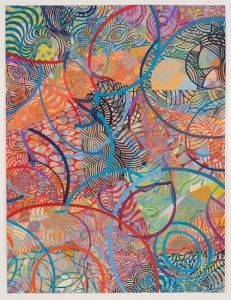
A similar separation of space through pattern takes place in Kate Abercrombie’s pieces, which vibrate with intense color combinations and geometric juxtapositions. In “The Catbird Seat,” a web of line leads us over and around a collage of delicate yet eye-popping designs in gouache. The collage-like overlay of shapes and textures is navigated by a series of looping red and blue ribbons, lazily snaking their way through the composition while creating focus and demarcation within the piece.
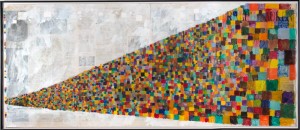
Mark Mahosky divides space into shape and void in his vibrant (mostly untitled) paintings on newspaper that make use of but go beyond their rainbow palette of colors. Trapped in a variety of shapes, dense squares of bright color shimmer, surrounded by textured white paint. The provocative background bears traces of images and fragmented phrases from the newspapers beneath the white wash. Sometimes there are delicate graphite marks. Mahosky toes the line between presence and absence in his work, providing a multi-faceted void full of dreamy mystery.
Altered books and videos of Jennifer Levonian
Jennifer Levonian’s animation “The Poetry Winner,” created through stop-motion manipulation of watercolor compositions, pokes fun at the archetype of the frustrating and apathetic modern college grad, with various characters play-acting a story of graduation weekend at a local college (Bryn Mawr College, for which the piece was commissioned). Creating works in the vein of old-fashioned children’s storybook illustrations feels like a design to distance the artist from her viewer, as if the child-like storytelling can conceal the very real fears and regressive tendencies that drove that choice. [It’s fair to note here that Levonian is not alone in successfully using this strategy in her art. See any Wes Anderson movie, for example.–Ed.]
More interesting works by Levonian are the art objects she has made out of three great books: “Middlemarch” by George Eliot, “Pilgrim at Tinker Creek” by Annie Dillard, and “The Life of Saint Teresa of Avila.” Each book’s cover is redesigned in watercolor according to the artist’s own experience of it, and is presented as part of a book, with the text and the furled pages adding to the appeal. These books look like living beings, representing a text not as static but as fluid, equally defined by the reader in the act of reading. After all, a real, ordinary book doesn’t look at all like what its contents are, but these pieces signify a kind of representation of a book actively being read. The concept seems to stop there and go no further, but Levonian may be onto something in tracking and redefining the relationships between the interiority of objects like books and their exterior appearances.
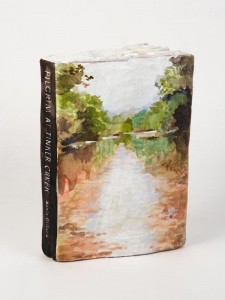
Other artists rounding out the show include the Dufala Brothers, Paul Swenbeck, Dan Murphy, Anthony Campuzano, Tristin Lowe, Nick Paparone, and Chris Canales.
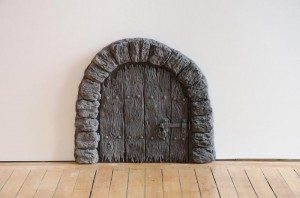
“New Wine, New Bottle” shows an impressive group of individual visions, united in their desire to pursue the expression of the unsteady ground between perception and reality. From the obsessively ornate decoration of banal snapshots to animate watercolor representation of books, Fleisher-Ollman’s curatorial vision here is at once a whimsical and relevant reaction to contemporary culture.
New Wine, New Bottle will be up at Fleisher-Ollman Gallery through August 30.



